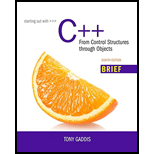
Starting Out with C++: From Control Structures through Objects, Brief Version plus MyLab Programming with Pearson eText - Access Card Package (8th Edition)
8th Edition
ISBN: 9780134059853
Author: Tony Gaddis
Publisher: PEARSON
expand_more
expand_more
format_list_bulleted
Expert Solution & Answer
Chapter 8, Problem 15RQE
Explanation of Solution
Sorting:
When contents of the array being arranged in the particular order is called as sorting. The order of arranging the contents can be ascending or descending order.
Ascending order:
When the elements present in the array are sorted from the lowest to highest is called as ascending order.
Example:
Consider the elements of array that are present in the ascending order below:
2, 4, 6, 8, 10 …&...
Expert Solution & Answer
Trending nowThis is a popular solution!

Students have asked these similar questions
Write the SQL code that permits to implement the tables: Student and Transcript. NB: Add the constraints on the attributes – keys and other.
Draw an ERD that will involve the entity types: Professor, Student, Department and Course. Be sure to add relationship types, key attributes, attributes and multiplicity on the ERD.
Draw an ERD that represents a book in a library system. Be sure to add relationship types, key attributes, attributes and multiplicity on the ERD.
Chapter 8 Solutions
Starting Out with C++: From Control Structures through Objects, Brief Version plus MyLab Programming with Pearson eText - Access Card Package (8th Edition)
Ch. 8.2 - Prob. 8.1CPCh. 8.2 - Prob. 8.2CPCh. 8.2 - Prob. 8.3CPCh. 8.2 - Prob. 8.4CPCh. 8 - Prob. 1RQECh. 8 - If a linear search function is searching for a...Ch. 8 - Prob. 3RQECh. 8 - A binary search function is searching for a value...Ch. 8 - What is the maximum number of comparisons that a...Ch. 8 - Prob. 6RQE
Ch. 8 - Why is the selection sort more efficient than the...Ch. 8 - Prob. 8RQECh. 8 - The __________ search algorithm repeatedly divides...Ch. 8 - Prob. 10RQECh. 8 - The ____________ search algorithm requires that...Ch. 8 - If an array is sorted in ______________ order, the...Ch. 8 - If an array is sorted in _____________ order, the...Ch. 8 - Prob. 14RQECh. 8 - Prob. 15RQECh. 8 - Prob. 16RQECh. 8 - T F The maximum number of comparisons performed by...Ch. 8 - Prob. 18RQECh. 8 - Charge Account Validation Write a program that...Ch. 8 - Lottery Winners A lottery ticket buyer purchases...Ch. 8 - Lottery Winners Modification Modify the program...Ch. 8 - Charge Account Validation Modification Modify the...Ch. 8 - Rainfall Statistics Modification Modify the...Ch. 8 - String Selection Sort Modify the selectionSort...Ch. 8 - Binary String Search Modify the binarySearch...Ch. 8 - Search Benchmarks Write a program that has an...Ch. 8 - Sorting Benchmarks Write a program that uses two...Ch. 8 - Sorting Orders Write a program that uses two...Ch. 8 - Using FilesString Selection Sort Modification...
Knowledge Booster
Similar questions
- 2:21 m Ο 21% AlmaNet WE ARE HIRING Experienced Freshers Salesforce Platform Developer APPLY NOW SEND YOUR CV: Email: hr.almanet@gmail.com Contact: +91 6264643660 Visit: www.almanet.in Locations: India, USA, UK, Vietnam (Remote & Hybrid Options Available)arrow_forwardProvide a detailed explanation of the architecture on the diagramarrow_forwardhello please explain the architecture in the diagram below. thanks youarrow_forward
- Complete the JavaScript function addPixels () to calculate the sum of pixelAmount and the given element's cssProperty value, and return the new "px" value. Ex: If helloElem's width is 150px, then calling addPixels (hello Elem, "width", 50) should return 150px + 50px = "200px". SHOW EXPECTED HTML JavaScript 1 function addPixels (element, cssProperty, pixelAmount) { 2 3 /* Your solution goes here *1 4 } 5 6 const helloElem = document.querySelector("# helloMessage"); 7 const newVal = addPixels (helloElem, "width", 50); 8 helloElem.style.setProperty("width", newVal); [arrow_forwardSolve in MATLABarrow_forwardHello please look at the attached picture. I need an detailed explanation of the architecturearrow_forward
- Information Security Risk and Vulnerability Assessment 1- Which TCP/IP protocol is used to convert the IP address to the Mac address? Explain 2-What popular switch feature allows you to create communication boundaries between systems connected to the switch3- what types of vulnerability directly related to the programmer of the software?4- Who ensures the entity implements appropriate security controls to protect an asset? Please do not use AI and add refrencearrow_forwardFind the voltage V0 across the 4K resistor using the mesh method or nodal analysis. Note: I have already simulated it and the value it should give is -1.714Varrow_forwardResolver por superposicionarrow_forward
- Describe three (3) Multiplexing techniques common for fiber optic linksarrow_forwardCould you help me to know features of the following concepts: - commercial CA - memory integrity - WMI filterarrow_forwardBriefly describe the issues involved in using ATM technology in Local Area Networksarrow_forward
arrow_back_ios
SEE MORE QUESTIONS
arrow_forward_ios
Recommended textbooks for you
- Programming Logic & Design ComprehensiveComputer ScienceISBN:9781337669405Author:FARRELLPublisher:CengageNp Ms Office 365/Excel 2016 I NtermedComputer ScienceISBN:9781337508841Author:CareyPublisher:Cengage
 Microsoft Visual C#Computer ScienceISBN:9781337102100Author:Joyce, Farrell.Publisher:Cengage Learning,
Microsoft Visual C#Computer ScienceISBN:9781337102100Author:Joyce, Farrell.Publisher:Cengage Learning, Programming with Microsoft Visual Basic 2017Computer ScienceISBN:9781337102124Author:Diane ZakPublisher:Cengage Learning
Programming with Microsoft Visual Basic 2017Computer ScienceISBN:9781337102124Author:Diane ZakPublisher:Cengage Learning Systems ArchitectureComputer ScienceISBN:9781305080195Author:Stephen D. BurdPublisher:Cengage Learning
Systems ArchitectureComputer ScienceISBN:9781305080195Author:Stephen D. BurdPublisher:Cengage Learning

Programming Logic & Design Comprehensive
Computer Science
ISBN:9781337669405
Author:FARRELL
Publisher:Cengage


Np Ms Office 365/Excel 2016 I Ntermed
Computer Science
ISBN:9781337508841
Author:Carey
Publisher:Cengage

Microsoft Visual C#
Computer Science
ISBN:9781337102100
Author:Joyce, Farrell.
Publisher:Cengage Learning,

Programming with Microsoft Visual Basic 2017
Computer Science
ISBN:9781337102124
Author:Diane Zak
Publisher:Cengage Learning

Systems Architecture
Computer Science
ISBN:9781305080195
Author:Stephen D. Burd
Publisher:Cengage Learning